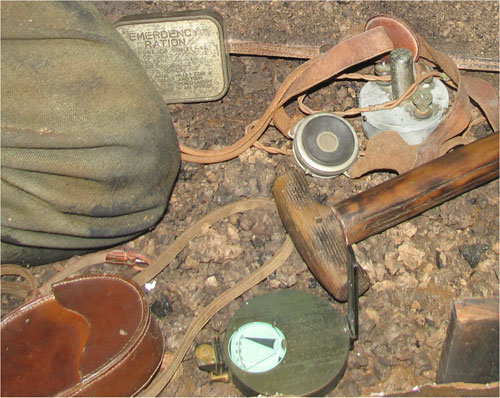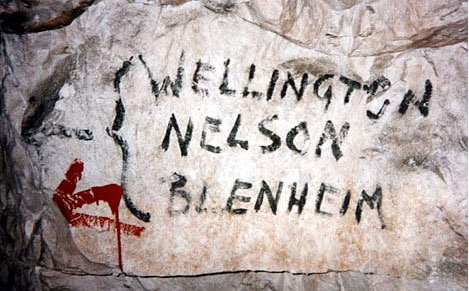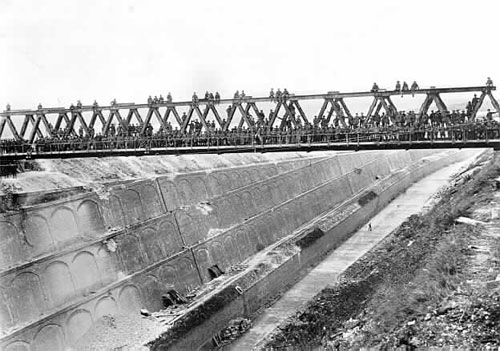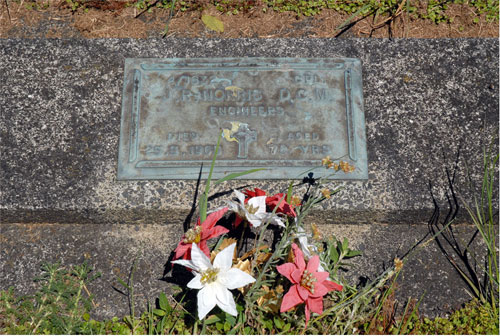
The New
Zealand Tunnelling Company
In September 1915 the Imperial Government requested that New Zealand raise an Engineer
Tunnelling Company of three or four hundred men.They would form one of 25 British and seven
Dominion Tunnelling Companies, totalling 25,000 men that would serve in France by late 1916.
The officers selected for commissions in the Tunnelling Companies were often mining engineers of
wide experience, recruited from all parts of the world, largely by the efforts of the
Institution of Mining and Metallurgy, and the Institution of Mining Engineers.
Miners in New Zealand were already a brotherhood before coming together to fight overseas. A
number with Australian origins would enlist from Waihi. Men like Sapper William Pascoe, whose
Australian gold miner father lived in Waihi, enlisted in the Australian Tunnelling Corps.
 In the Waihi region these men
were coming from what was one of the foremost industrial sites in New Zealand. The region was
widely regarded for its technical innovations such as the introduction of electric power, the
development of tube mills, and the refinement of cyanide gold recovery technology.
In the Waihi region these men
were coming from what was one of the foremost industrial sites in New Zealand. The region was
widely regarded for its technical innovations such as the introduction of electric power, the
development of tube mills, and the refinement of cyanide gold recovery technology.
Many miners had strong political views. In New Zealand arguably the most well known example is
the Waihi May - November 1912 strike that divided the town. Events reached a climax with the
storming of the Miners’ Hall and the ‘Black Tuesday’ death of a striker.
left: The
Hauraki Goldfield was widely regarded for its technical innovations.
Mining communities were no strangers to loss and deprivation.
It was against this background of comradeship, innovation, self-sufficiency, strong conviction
and fierce pride that Waihi would supply the second largest group of men to enlist, with only
Auckland providing more.
Tunnelling Company enlistments were, on the average, middle aged, ranging from thirty up. A
newspaper of the day reports: ‘All were strong and hardy. These were no boys playing at
war, but mature men, hard of muscle, hand and face.’
By October 1915, the entire company was assembled on Avondale Racecourse in Auckland.
The officers were drawn chiefly from the engineering staff of the Public Works Department, with
a sprinkling of Mining Engineers. They had all worked with men from the ordinary ranks in civil
life and knew and sympathised with their outlook.
Prior to his enlistment Captain Daniel Black Waters was Professor of Mining and Metallurgy at
the University of Otago. In 1915 he was also Vice-President of the Australasian Institute of
Mining Engineers, the forerunner of the AusIMM.
It was felt at the time that as the men were “experts in the class of work for which they
were called up,” there was no need for technical training, as in learning how to dig
tunnels and use the equipment of the day.
Instead, the men were taught squad drill without arms, learning to take orders, and routine
duties. ‘Lectures were given on saluting, dress, military law, health and other
subjects’.

above:
Tunnelling Company enlistments on parade at Avondale Racecourse in Auckland.
The 26 November Poverty Bay Herald reported:
The Tunnelling Company, at present in camp at Avondale, Auckland, is reported to have earned
the name of the "Red Feds". There are at present in camp with this company eleven
members who were formerly secretaries of various trade unions, whilst there are over forty
who are erstwhile members of trade union committees. Most of the men in the company, are
miners who have learned their business in a hard school, and are very efficient in their own
special line. They have learned to fight their own battles.
There were to be a number of conflicts between the tunnellers and civilian authorities, many
writers describing the company as shaking up the near-by city of Auckland as it had never been
shaken before.

above:
Farewell for the New Zealand Tunnelling Company in Auckland.
The New Zealand Tunnelling Corps of Engineers left Avondale on 18 December 1915. It was noted
that, ‘the only enthusiasm the citizens of Auckland showed to the company was when they
bade it farewell’.
The Company disembarked at Plymouth and entrained for Falmouth, Cornwall where they received
training from British instructors.
It was reported that ‘Such men did not take kindly to drill and were later famed throughout
the Expeditionary force as being the toughest and roughest Company’.
The Main Body reached the Western Front in March 1916. They were the first New Zealand
Expeditionary Force men on the Western front.
No Geological establishment ever existed in the British army. Among the headquarters staff of
the Australian Mining Corps which would arrive after the New Zealanders was Major T. W.
Edgeworth David, a distinguished Professor of Geology from Sydney University who was associated
with the foundation of the Australian Tunnellers Corps.
Despite his uniform and military title, he was known as “The Professor” and would act
as geological advisor. A complete knowledge of the geology of the area was essential,
particularly the water level, for in some parts of the chalk country the miners would encounter,
the difference between summer and winter water levels varied as much as 30 feet. Initially deep
level galleries were temporarily lost by both sides due to this lack of knowledge.
There were miners in other companies too. When the New Zealand Rifle Brigade arrived on the
Western Front, men with mining backgrounds were attached to assist the work of the Australian
Tunnelling Companies. On one occasion, the New Zealand miners were detailed for the sinking of
the "Anzac Shaft," with its series of galleries, in trench 74 of the Armentieres
sector. This was the first satisfactory steel-lined water-tight shaft ever sunk in the Second
Army area; and the whole of the work was executed by New Zealanders.
The New Zealand Tunnelling Company first operated at the foot of Vimy Ridge near Arras, in a
counter-mining role. The underground war was a deadly affair, which hinged on the speed of the
digging. Tunnellers would dig a long shaft under the enemy trench system and carve out a bigger
cave at the end of the tunnel.
They would then pack the end cave with about 3000 pounds of explosives, retreat and detonate
it.
When an explosion of this size went off underground, everyone in nearby tunnels, even
unconnected to the explosion, was killed by carbon monoxide created by the blast.
As they dug, the tunnellers would listen to the digging sounds of the enemy. When digging
stopped and you could hear the enemy packing explosives you knew that if you weren't ready to
blow, you’d lost the race.
The New Zealand tunnellers dug at three times the rate of the German tunnellers and won the race
virtually every time. Only once during the war did the enemy blow a mine before the Kiwis were
able to counter-mine.

In the early days New Zealand Tunnellers knew nothing of geophone listening and they had to
learn mine rescue work and other details of mining practice as they went. Teams were sent for
training and it was a fast learning curve.
left: Geophone
listening device used by tunnellers to listen for enemy activity underground.
The tunnellers were transferred to Arras, staying there for the next two years.
It was at Arras that the New Zealanders abandoned the Royal Engineers’ method of tunnel,
switching to a more “Kiwi version” -- a typical New Zealand gallery, would be 6 feet
high by 3 feet 6 inches wide – wider and higher than the tunnels the British were used to
constructing – for “decent room to swing a pick.” They were big men and dug big
tunnels. And because they liked to see the ground they were working in – arguing that it
talks to miners who know the language – the tunnels were unlined and only supported here
and there by rough props.
The New Zealanders’ methods also differed one other respect. The British sank a vertical
shaft in a position as far forward as possible. These were vulnerable to enemy bombardment and
raiding parties. The handling of spoil was a slow and laborious task and dumping the spoil at
the surface often gave away the position of the shaft. The Kiwis preferred to commence
operations a little further back where they could conceal the mine entrance more readily and
better conceal the spoil above ground. A decline was driven to a point where a main lateral
gallery ran below the front trench line.

The company also had the job of disposing of damaged ammunition. In one incident 13,000 shells
were lowered 95 feet below the surface and stacked in one of the old mine galleries. 45 electric
detonators were prepared for an explosion.
Quite a crowd gathered to watch. When the exploder handle was shoved home, a huge column of
smoke and debris rose high in the air and slowly drifted leeward. It was reported that troops
four miles away “stood to” for a gas attack. The explosion also left a smoking
seventy-foot crater.
In Arras, the New Zealanders were credited with the discovery of old underground quarries,
limestone caverns that been excavated to provide material to rebuild the city of Arras in the
seventeenth century.
right: A
cartoon of the day. 'They must 'ave 'ad some good news or somethin', Alf;you can 'ear 'em
cheerin' quite plain'.
With a major Allied push planned for April 1917, the New Zealanders worked in the Ronville
system. They found immense caverns hundreds of feet in diameter and twenty to forty feet high.
Work began to connect and open up the underground quarries to make the system suitable to house
troops, so that when the day for the attack came the men would emerge from them safe, warm and
dry – and unsuspected by the enemy.
The chalk stone was white, resembling the Oamaru stone of New Zealand, only finer and denser in
structure, and capable of being more finely carved. The cavern system was mined in much the same
manner as a coal seam, with pillars of stone being left to support the ground overhead.
As soon as the caverns were opened to the cold wet winter air, the chalk began to swell and
crack, and slabs weighing many tons would come crashing down without warning. To timber up to
the heights of the high roofs in the Ronville caves was out of the question, so instead the
floor was raising by dumping the chalk cut from the galleries and dugouts until the roof was
close enough for clear observation and support.
For two months they were assisted by the New Zealand Pioneer Battalion, many of whose members
had been part of the Native (Maori) Contingent. Members of the NZ Infantry would replace the
Pioneers. Today you can still see names etched on the walls.
To assist orientation New Zealanders gave the caverns along their line names from home: Russell,
Auckland, New Plymouth, Wellington, Nelson, Blenheim, Christchurch, Dunedin and Bluff.
below:
Familiar names were painted and carved into the chalk.
 The caves were fitted with gas
doors, electricity, ventilating plant, running water and other facilities including a hospital
and operating theatre. Ventilation was good, the only difficulty being gas attacks, when plenty
of ventilation actually increased the danger.
The caves were fitted with gas
doors, electricity, ventilating plant, running water and other facilities including a hospital
and operating theatre. Ventilation was good, the only difficulty being gas attacks, when plenty
of ventilation actually increased the danger.
As they tunnelled towards the enemy lines three mines were laid under German trenches for
detonation when the attack began.
The cavern system was reputed to be large enough to hold between 20,000 and 25,000 men, although
during the cold winter months of the campaign known as the Battle of Arras, only half would
actually be in residence at any one time. It is thought that up to 30,000 men slept one or more
nights in the caves and many more passed through them. The development of underground shelter
for attacking troops to the extent carried out at Arras by the New Zealand Tunnelling Company is
believed to be unique in military history.
The highly secret job finished in time for the 9 April 1917 assault. the Company’s skill
and effort were such that they were mentioned in Parliament in New Zealand.
Don’t think that the Tunneling Company had an easy job. One account details their
experiences.
Leading up to zero hour Tunnelling Companies duties included repairing the constantly crumped
forward saps. The night before the assault the tunnel face was well under the German wire and
just 25 yards from the parapet of the German front line trench. A prepared machine gun lay in
position behind a couple of feet of cover that the tunnellers were to remove just before Zero
and to open the end of the gallery into No-man’s land, continuing it as an open trench into
the German front line, immediately the battle opened.
Unfortunately a ‘friendly’ shell fell short, landed in the gallery with gas filling
the space. A hastily rigged gas curtain was rigged behind the first opening – an incline up
to the front trench. The end had to be opened up to clear the gas out. This meant groping by dim
candle light, through a hundred and fifty yards of narrow winding gallery with eyes streaming
and smarting from the tear gas that got in under the box respirators. Constant relays of men
were necessary before the work was done.
 The next big task given to the
New Zealand Tunnellers was the construction of the Havrincourt Bridge over the Canal du Nord. It
was to be a notable engineering feat. The men were not a trained bridging company and had little
equipment for the task. Up to the morning of the attack the canal was practically front line so
no preliminary work could be done beyond taking measurements. The type of bridge to be erected
was the pre fabricated steel “Hopkins’, designed to carry heavy loads across a clear
span between supports of 120 feet. The canal was at that point through a cutting 85 feet deep
and with a distance of 180 feet.
The next big task given to the
New Zealand Tunnellers was the construction of the Havrincourt Bridge over the Canal du Nord. It
was to be a notable engineering feat. The men were not a trained bridging company and had little
equipment for the task. Up to the morning of the attack the canal was practically front line so
no preliminary work could be done beyond taking measurements. The type of bridge to be erected
was the pre fabricated steel “Hopkins’, designed to carry heavy loads across a clear
span between supports of 120 feet. The canal was at that point through a cutting 85 feet deep
and with a distance of 180 feet.
left: The
Havrincourt Bridge
From an engineering point of view the task set Captain J.D. Holmes acting O.C Company, verged on
the impossible.
Eight days from start, the bridge was finished, complete with footways and handrails. It was
reputed to have been the longest single span military bridge up to that time. Captain Holmes was
the son of R W Holmes, the public works engineer who was responsible for another remarkable
engineering feat, on the North Island railway known as the Raurimu Spiral.
As the war finished, a legacy of ‘miners at war’ stories includes;
Professor D B Waters of Otago University, one time manager and general manager of mining
companies in both Australia and New Zealand and for a brief time while serving overseas, OC of
the NZ Tunnelling Company would return home but with his health was damaged by war service.
 Waihi’s Lance-Corporal Jack
Norris was awarded a DCM His citation reads; “For conspicuous gallantry and devotion to
duty. He displayed the great coolness and courage when he and his party were entombed in a
gallery. There was a great risk of the workings being discovered, but he succeeded in getting
his party dug out undetected.”
Waihi’s Lance-Corporal Jack
Norris was awarded a DCM His citation reads; “For conspicuous gallantry and devotion to
duty. He displayed the great coolness and courage when he and his party were entombed in a
gallery. There was a great risk of the workings being discovered, but he succeeded in getting
his party dug out undetected.”
Norris displayed qualities miners were known for. They would readily sacrifice their lives to
save their workmates.
right: Lance
Corporal Jack Norris is buried in Waihi.
An unveiling ceremony of the War Memorial of the Institution of Mining and Metallurgy was held
in London in 1921.
Attending was Field –Marshall Earl Haig, senior commander of the World War One British
Expeditionary Force. In his address he said, ‘You have afforded me an opportunity to say
a few words of special thanks for a body of men in France that seldom drew upon itself much
notice or glory at the time, but was surpassed by none in the demands it made upon the
skill, the courage and the resolution of the individuals concerned, or in the services it
rendered to the Army as a whole.
Few outside of those who took part in the work and benefited by its results realise the
immense amount of steady, persistent toil in every circumstance of peril, surrounded by
danger in a form that might appall the stoutest hearted, that went to the preparation of
triumph. Few realise how vast, how important to the safety, comfort, and success of our
troops, was the work of the miners, work that was little commented upon in the Press, but
yet went steadily and continuously, day after day, and year after year, along the whole of
the British Front.’
Until recently, few people have known about the stories of the special group men who fought an
underground war or of the men from the Hauraki goldfields from places like Waihi, Karangahake,
Thames and Waitekauri.
They left from the mines to work in secret, underground in France. They worked in extreme work
and weather conditions. They were buried underground, gassed and shelled. At their own special
work, mine warfare, they showed the highest qualities both as military engineers as well as
fighting troops.
.
They returned to New Zealand, to Waihi and their jobs. In their home country, they were
forgotten.
We would like to remedy that. As we head towards the centennial commemorations of World War One
there are plans to erect a Memorial to New Zealand Tunnellers in Waihi.
(Extracts from ANZAC Day presentation, 2008)
Miners at War
written for Quarrying & Mining magazine
On the Western Front
Personal accounts and newspaper reports
News from the Other Side of the World
Letters home (PDF)
A Tunneller's grandson tells his story
Committee member Mike Roycroft tells the story of his grandfather
The Caves of Arras
Thames Star 1917
Good War Service
Evening Post 1919
Most Frightful Fight Ever Seen
Wanganui Chronicle 1917
The New Zealand Tunnelling Company
J.C.Neill, 1922
Waihi Tunnellers
Maori Television 2010
Unit
War Diary, Arras
Nov 1916-April 1917
It was felt at the time that as the men were 'experts in the class of work for which they were called up', there was no need for technical training, as in learning how to dig tunnels and use the equipment of the day.
...many writers described the company as shaking up the near-by city of Auckland as it had never been shaken before.
‘the only enthusiasm the citizens of Auckland showed to the company was when they bade it farewell’.
The underground war was a deadly affair, which hinged on the speed of the digging.
To assist orientation New Zealanders gave the caverns along their line names from home: Russell, Auckland, New Plymouth, Wellington, Nelson, Blenheim, Christchurch, Dunedin and Bluff.